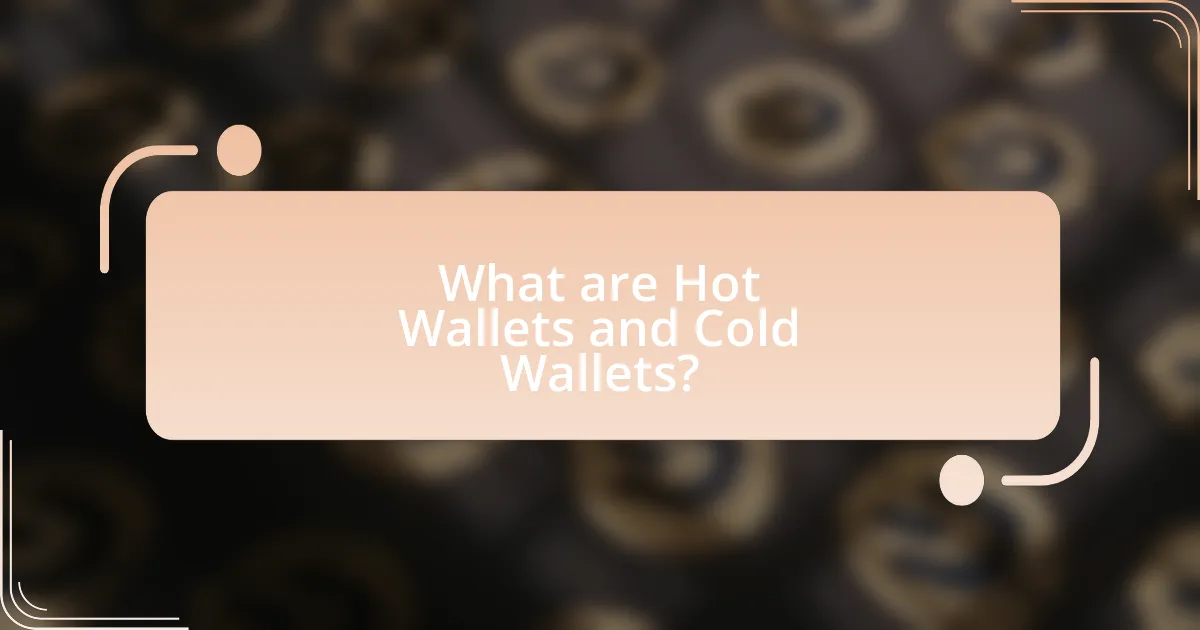Hot wallets and cold wallets are two primary types of digital wallets used for storing cryptocurrencies, each with distinct advantages and disadvantages. Hot wallets, which are connected to the internet, offer convenience and quick access for frequent transactions but are more vulnerable to hacking and cyber threats. In contrast, cold wallets provide enhanced security by keeping private keys offline, making them ideal for long-term storage, though they come with limitations in accessibility and usability. This article compares the features, security measures, and user considerations of hot and cold wallets, helping users make informed decisions based on their cryptocurrency management needs.

What are Hot Wallets and Cold Wallets?
Hot wallets are digital wallets that are connected to the internet, allowing for quick and easy access to cryptocurrencies for transactions. They are typically used for everyday trading and spending due to their convenience. In contrast, cold wallets are offline storage solutions for cryptocurrencies, providing enhanced security by keeping private keys away from internet access. This makes cold wallets ideal for long-term storage of digital assets, as they are less vulnerable to hacking and online threats. The distinction between hot and cold wallets is crucial for users to manage their cryptocurrency holdings effectively, balancing accessibility with security.
How do Hot Wallets function in cryptocurrency management?
Hot wallets function in cryptocurrency management by providing a digital interface for users to store, send, and receive cryptocurrencies while being connected to the internet. This connectivity allows for quick transactions and easy access to funds, making hot wallets ideal for frequent trading or everyday use. However, their online nature also exposes them to higher security risks, such as hacking and phishing attacks, compared to cold wallets, which are offline and more secure. The balance between accessibility and security is a critical aspect of hot wallet functionality in managing cryptocurrency assets.
What types of Hot Wallets are available?
There are several types of hot wallets available, including web wallets, mobile wallets, and desktop wallets. Web wallets are accessible through internet browsers and are often provided by cryptocurrency exchanges, allowing users to manage their assets online. Mobile wallets are applications installed on smartphones, offering convenience for transactions on the go. Desktop wallets are software programs downloaded to personal computers, providing users with control over their private keys while remaining connected to the internet. Each type of hot wallet facilitates quick access to cryptocurrencies but comes with varying levels of security risks due to their online nature.
What security measures do Hot Wallets implement?
Hot wallets implement several security measures to protect digital assets, including encryption, two-factor authentication (2FA), and regular software updates. Encryption secures user data and transaction information, making it difficult for unauthorized parties to access sensitive information. Two-factor authentication adds an additional layer of security by requiring users to verify their identity through a secondary method, such as a mobile app or SMS code. Regular software updates ensure that any vulnerabilities are patched promptly, reducing the risk of exploitation. These measures collectively enhance the security of hot wallets, which are more susceptible to online threats compared to cold wallets.
How do Cold Wallets operate for secure storage?
Cold wallets operate for secure storage by keeping private keys offline, which significantly reduces the risk of unauthorized access and hacking. These wallets can take the form of hardware devices or paper wallets, ensuring that the keys necessary for cryptocurrency transactions are not exposed to the internet. For instance, hardware wallets like Ledger and Trezor store keys in a secure chip, making them immune to malware attacks that target online wallets. This offline nature of cold wallets is a critical factor in their security, as it eliminates vulnerabilities associated with internet connectivity.
What are the different types of Cold Wallets?
The different types of cold wallets include hardware wallets, paper wallets, and offline software wallets. Hardware wallets, such as Trezor and Ledger, store private keys on a physical device, providing enhanced security against online threats. Paper wallets involve printing the private keys and public addresses on paper, which can be stored securely but are vulnerable to physical damage or loss. Offline software wallets, also known as air-gapped wallets, are installed on a computer that is never connected to the internet, ensuring that private keys remain secure from online attacks. Each type of cold wallet offers distinct advantages in terms of security and usability, making them suitable for different user needs.
What security features make Cold Wallets reliable?
Cold wallets are reliable due to their offline storage capability, which significantly reduces the risk of hacking. By keeping private keys disconnected from the internet, cold wallets protect against online threats such as malware and phishing attacks. Additionally, many cold wallets utilize hardware encryption, ensuring that even if the device is physically compromised, the stored data remains secure. The use of multi-signature technology further enhances security by requiring multiple approvals for transactions, making unauthorized access more difficult. These features collectively establish cold wallets as a secure option for cryptocurrency storage.

What are the Pros and Cons of Hot Wallets?
Hot wallets offer the advantage of convenience and accessibility, allowing users to quickly send and receive cryptocurrencies. This is particularly beneficial for frequent traders or those who need immediate access to their funds. However, the primary disadvantage of hot wallets is their vulnerability to hacking and cyber attacks, as they are connected to the internet. According to a report by Chainalysis, in 2021, over $3.2 billion was stolen from hot wallets, highlighting the security risks associated with their use.
What advantages do Hot Wallets offer to users?
Hot wallets offer users the advantage of convenience and accessibility for managing cryptocurrencies. They allow for quick transactions and easy access to funds, making them ideal for frequent trading or everyday use. Additionally, hot wallets typically support a wide range of cryptocurrencies, enhancing user flexibility. Their integration with various platforms and services further simplifies the process of buying, selling, and transferring digital assets.
How do Hot Wallets enhance accessibility and convenience?
Hot wallets enhance accessibility and convenience by allowing users to easily access their cryptocurrencies through internet-connected devices. This immediate access facilitates quick transactions, enabling users to buy, sell, or trade digital assets without the delays associated with offline storage solutions. Additionally, hot wallets often come with user-friendly interfaces and mobile applications, making it simple for individuals to manage their assets on the go. The integration of features such as QR code scanning further streamlines the transaction process, reinforcing the overall convenience of using hot wallets for everyday cryptocurrency activities.
What are the risks associated with using Hot Wallets?
Hot wallets are associated with several risks, primarily due to their constant connection to the internet. This connectivity makes them vulnerable to hacking, as cybercriminals can exploit security weaknesses to gain unauthorized access to funds. For instance, in 2020, the KuCoin exchange suffered a hack that resulted in the loss of over $280 million, highlighting the dangers of using hot wallets for storing significant amounts of cryptocurrency. Additionally, hot wallets are susceptible to phishing attacks, where users may inadvertently provide their private keys or login credentials to malicious actors. Furthermore, the reliance on third-party services for security can lead to risks if those services experience breaches or failures. Overall, the inherent online exposure of hot wallets significantly increases the likelihood of theft and loss of assets.
How do Hot Wallets compare in terms of security?
Hot wallets are generally less secure than cold wallets due to their constant connection to the internet, making them more vulnerable to hacking and cyber attacks. For instance, a 2020 report by Chainalysis indicated that over $1.9 billion was stolen from hot wallets through various cyber incidents. In contrast, cold wallets, which are offline storage solutions, provide enhanced security by isolating private keys from online threats. Therefore, while hot wallets offer convenience for frequent transactions, their security risks are significantly higher compared to cold wallets.
What vulnerabilities do Hot Wallets face?
Hot wallets face several vulnerabilities primarily due to their constant connection to the internet. This exposure makes them susceptible to hacking, phishing attacks, and malware, which can lead to unauthorized access and theft of funds. For instance, a notable incident occurred in 2019 when the cryptocurrency exchange Binance was hacked, resulting in the loss of over $40 million worth of Bitcoin from its hot wallet. Additionally, hot wallets are also vulnerable to human error, such as accidentally sharing private keys or falling for scams, which can compromise security. These factors collectively highlight the inherent risks associated with using hot wallets for cryptocurrency storage.
How can users mitigate risks when using Hot Wallets?
Users can mitigate risks when using hot wallets by implementing strong security measures such as enabling two-factor authentication (2FA), regularly updating software, and using unique, complex passwords. Two-factor authentication adds an extra layer of security, making unauthorized access more difficult. Regular software updates ensure that users benefit from the latest security patches, reducing vulnerabilities. Additionally, using unique passwords minimizes the risk of account compromise from data breaches. According to a 2021 report by the Cybersecurity & Infrastructure Security Agency, 80% of data breaches involve weak or stolen passwords, highlighting the importance of robust password practices.

What are the Pros and Cons of Cold Wallets?
Cold wallets offer significant advantages and disadvantages for cryptocurrency storage. The primary pros include enhanced security, as cold wallets are offline and less susceptible to hacking, and long-term storage capabilities, making them ideal for holding large amounts of cryptocurrency without frequent access. For instance, hardware wallets, a type of cold wallet, have been shown to provide robust protection against cyber threats.
Conversely, the cons of cold wallets involve limited accessibility, as users must connect to a device to access their funds, which can be inconvenient for frequent transactions. Additionally, cold wallets can be lost or damaged, leading to potential loss of funds if proper backup measures are not in place. For example, if a hardware wallet is misplaced without a recovery seed, the stored cryptocurrencies may become irretrievable.
What benefits do Cold Wallets provide for cryptocurrency storage?
Cold wallets provide enhanced security for cryptocurrency storage by keeping private keys offline, significantly reducing the risk of hacking and unauthorized access. This offline storage method protects assets from online threats, as cold wallets are not connected to the internet, making them immune to malware and phishing attacks. Additionally, cold wallets often support multiple cryptocurrencies and allow users to maintain full control over their private keys, which is crucial for safeguarding digital assets. According to a report by the Blockchain Research Institute, cold storage solutions are considered one of the safest methods for long-term cryptocurrency holding, as they minimize exposure to cyber risks.
How do Cold Wallets ensure long-term security?
Cold wallets ensure long-term security by storing cryptocurrencies offline, which significantly reduces the risk of hacking and unauthorized access. Unlike hot wallets, which are connected to the internet and vulnerable to cyber threats, cold wallets utilize hardware or paper forms to keep private keys secure. This offline storage method protects assets from malware and phishing attacks, as the wallet is not exposed to online vulnerabilities. Additionally, cold wallets often incorporate encryption and secure backup options, further enhancing their security measures.
What limitations do Cold Wallets have in terms of usability?
Cold wallets have significant limitations in terms of usability, primarily due to their offline nature. This offline status makes transactions less convenient, as users must connect the wallet to a device to access funds, which can be cumbersome and time-consuming. Additionally, cold wallets often lack user-friendly interfaces, making them less accessible for individuals who are not technologically savvy. The requirement for physical access to the wallet can also hinder quick transactions, especially in urgent situations. Furthermore, the process of transferring funds from a cold wallet to a hot wallet involves multiple steps, increasing the potential for user error. These factors collectively contribute to the usability challenges associated with cold wallets.
How do Cold Wallets compare in terms of accessibility?
Cold wallets are less accessible than hot wallets due to their offline nature, which requires physical access to the device for transactions. This limited accessibility enhances security but makes it less convenient for frequent transactions. For instance, while hot wallets allow instant access to funds via the internet, cold wallets necessitate a more deliberate process, such as connecting a hardware wallet to a computer. This distinction is crucial for users who prioritize security over convenience, as cold wallets effectively protect assets from online threats but at the cost of immediate accessibility.
What challenges do users face when accessing Cold Wallets?
Users face several challenges when accessing cold wallets, primarily related to usability and security. Cold wallets, which store cryptocurrencies offline, can be cumbersome to access due to the need for physical devices like hardware wallets or paper wallets. This physical requirement can lead to difficulties in retrieving funds quickly, especially in urgent situations. Additionally, users must manage private keys securely; losing these keys can result in permanent loss of access to their assets. Furthermore, the complexity of setting up and using cold wallets can deter less tech-savvy individuals, leading to potential errors during transactions. These challenges highlight the trade-offs between enhanced security and accessibility in cold wallet usage.
How can users effectively manage their Cold Wallets?
Users can effectively manage their cold wallets by ensuring secure storage, regular backups, and maintaining updated security practices. Secure storage involves keeping the cold wallet in a safe physical location, such as a safe or safety deposit box, to prevent theft or loss. Regular backups of wallet recovery phrases or private keys should be made and stored separately from the wallet itself, ensuring that users can recover their assets if needed. Additionally, users should stay informed about the latest security threats and best practices, such as using strong passwords and enabling two-factor authentication where applicable. These measures help protect against unauthorized access and loss of funds, reinforcing the importance of diligence in cold wallet management.

How do Hot Wallets and Cold Wallets compare overall?
Hot wallets and cold wallets differ primarily in their connectivity and security features. Hot wallets are connected to the internet, allowing for quick access and transactions, making them convenient for frequent trading. In contrast, cold wallets are offline storage solutions, providing enhanced security against hacking and online threats, which is ideal for long-term asset holding. According to a report by the Blockchain Research Institute, cold wallets can reduce the risk of theft by up to 90% compared to hot wallets, highlighting their superior security for storing cryptocurrencies.
What factors should users consider when choosing between Hot and Cold Wallets?
Users should consider security, accessibility, and intended use when choosing between Hot and Cold Wallets. Hot Wallets, which are connected to the internet, offer greater accessibility for frequent transactions but are more vulnerable to hacking. In contrast, Cold Wallets, which are offline, provide enhanced security against cyber threats but are less convenient for quick access. According to a report by the Blockchain Research Institute, Cold Wallets are recommended for long-term storage of significant amounts of cryptocurrency due to their robust security features.
How do user needs influence the choice of wallet type?
User needs significantly influence the choice of wallet type by determining the balance between accessibility and security. For instance, users who prioritize quick access to their funds for frequent transactions often opt for hot wallets, which are connected to the internet and provide ease of use. Conversely, users who prioritize the security of their assets, particularly those holding large amounts of cryptocurrency, tend to choose cold wallets, which are offline and less vulnerable to hacking. This distinction is supported by a survey conducted by the Cambridge Centre for Alternative Finance, which found that 70% of cryptocurrency holders prefer hot wallets for daily transactions, while 60% of long-term investors utilize cold wallets for enhanced security.
What scenarios favor the use of Hot Wallets over Cold Wallets?
Hot wallets are favored in scenarios requiring frequent transactions and immediate access to funds. For example, traders actively buying and selling cryptocurrencies benefit from hot wallets due to their online connectivity, allowing for quick transfers and real-time market engagement. Additionally, businesses accepting cryptocurrency payments often utilize hot wallets for their ease of use and rapid transaction processing, which is essential for customer satisfaction and operational efficiency. The need for liquidity and accessibility in these situations makes hot wallets a practical choice over cold wallets, which are more secure but less convenient for immediate transactions.
What best practices should users follow for wallet security?
To ensure wallet security, users should implement strong password practices, enable two-factor authentication, and regularly update their software. Strong passwords should be complex, combining letters, numbers, and symbols, making them difficult to guess. Two-factor authentication adds an additional layer of security by requiring a second form of verification, significantly reducing the risk of unauthorized access. Regular software updates are crucial as they often include security patches that protect against vulnerabilities. According to a 2021 report by the Cybersecurity & Infrastructure Security Agency, 80% of data breaches could be prevented with proper security measures, highlighting the importance of these best practices.
How can users enhance the security of their Hot Wallets?
Users can enhance the security of their Hot Wallets by implementing strong passwords and enabling two-factor authentication (2FA). Strong passwords reduce the risk of unauthorized access, while 2FA adds an additional layer of security by requiring a second form of verification, such as a text message or authentication app. According to a study by the Cybersecurity & Infrastructure Security Agency, using 2FA can block 99.9% of automated attacks, highlighting its effectiveness in protecting digital assets. Additionally, users should regularly update their wallet software to patch vulnerabilities and avoid using public Wi-Fi networks for transactions, as these can expose wallets to potential threats.
What steps can users take to protect their Cold Wallets effectively?
Users can protect their cold wallets effectively by implementing several key security measures. First, they should store their cold wallets in a secure, offline location, such as a safe or safety deposit box, to prevent unauthorized access. Additionally, users must ensure that their private keys are never exposed to the internet, as this significantly reduces the risk of hacking.
Using strong, unique passwords for any associated accounts and enabling two-factor authentication can further enhance security. Regularly updating the wallet’s firmware and software, when applicable, helps protect against vulnerabilities. Lastly, users should create multiple backups of their wallet data and store them in different secure locations to safeguard against loss or damage. These steps collectively minimize the risk of theft and ensure the integrity of the cold wallet.